Athetoid movements - Study guides, Class notes & Summaries
Looking for the best study guides, study notes and summaries about Athetoid movements? On this page you'll find 178 study documents about Athetoid movements.
Page 3 out of 178 results
Sort by
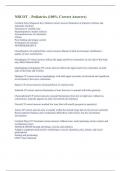
-
NBCOT – Pediatrics (100% Correct Answers)
- Exam (elaborations) • 7 pages • 2023
-
Available in package deal
-
- $9.89
- + learn more
Cerebral Palsy Diagnosis Key Markers correct answers Retention of primitive reflexes and automatic reactions Abnormal or variable tone Hyperresponsive tendon reflexes Asymmetrical use of extremities Clonus Poor feeding and tongue control Involuntary movements NONPROGRESSIVE Classification of Cerebral Palsy correct answers Based on limb involvement, distribution / quality of tone, and function Hemiplegia CP correct answers affects the upper and lower extremities on one side of the bo...

-
NSG MISC Family Nursing Final COMPLETE Exam Questions and Answers Latest 2024 Graded A+
- Exam (elaborations) • 45 pages • 2024
-
- $15.49
- + learn more
NSG MISC Family Nursing Final COMPLETE Exam Questions and Answers Latest 2024 Graded A+. What is most important for a nurse to teach the parents of a child with Duchenne muscular dystrophy to do for their child? Perform ROM exercises The nurse is counseling the parents of a 12-year-old child with Duchenne muscular dystrophy about problems that may develop during adolescence. What body system does the nurse expect will be affected? Cardiopulmonary A child has a right femur fracture ...
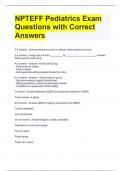
-
NPTEFF Pediatrics Exam Questions with Correct Answers.docx
- Exam (elaborations) • 8 pages • 2024
-
Available in package deal
-
- $13.89
- + learn more
NPTEFF Pediatrics Exam Questions with Correct A 2-3 months - Answer-Assumes prone on elbows (when placed in prone) Rolls supine to side lying 4-5 months - Answer-- Pull to sit NO lag -Rolls prone to supine -Feet to mouth -Self supported sitting propped forward on arms 6-7 months - Answer-- Rolls supine to prone -Sits alone without support (hands free) -Sitting equilibrium: protective extension forward -Transitions to quadruped to/from sitting 7 months - Answer-Maintains QDPD a...
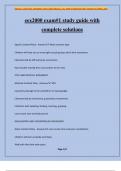
-
eex2000 exam#1 study guide with complete solutions
- Exam (elaborations) • 9 pages • 2024
-
- $9.99
- + learn more
eex2000 exam#1 study guide with complete solutions Spastic Cerebral Palsy - Answer-Most common type. Children will have one or more tight muscle groups which limit movement. Characterized by stiff and jerky movements. Have trouble moving from one position to the next. STIFF AND DIFFICULT MOVEMENT. Athetoid Cerebral Palsy - Answer-10% Caused by damage to the cerebellum or basal ganglia. Characterized by involuntary, purposeless movements. Interferes with speaking, feeding, reaching, gra...
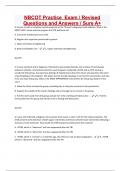
-
NBCOT Practice Exam / Revised Questions and Answers / Sure A+
- Exam (elaborations) • 19 pages • 2024
-
- $12.49
- + learn more
A 15-year-ol with a complete myelomenigocele at the T9 level is diagnosed with diabetes. What is the MOST LIKELY home exercise program the OTR will focus on? A. Consumer-initiated pressure relief B. Regular skin inspection performed by parent C. Upper extremity strengthening D. Bowl and bladder care - C. Upper extremity strengthening Quiz #5 A 17 year old client with a diagnosis of borderline personality disorder and a history of self-abusive behaviors attends a transitional school-to-wo...
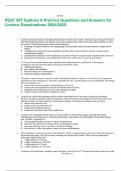
-
PEAT 507 Sullivan A Practice Questions and Answers for Licence Examinations 2024/2025.
- Exam (elaborations) • 32 pages • 2024
- Available in package deal
-
- $20.49
- + learn more
PEAT 507 Sullivan A Practice Questions and Answers for Licence Examinations 2024/2025. 1. A patient sustained a fracture to the left proximal humerus which is now healed. Treatment is proceeding well except that with left shoulder flexion. The therapist notices the scapula protracts and elevates early and it continues to move excessively. Physical therapy intervention should emphasize: A. stretching of scapular stabilizers and strengthening of the pectoralis major and minor ...
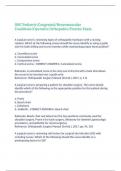
-
ONC Pediatric/Congenital/Neuromuscular Conditions/Operative Orthopedics Practice Exam,100% CORRECT
- Exam (elaborations) • 22 pages • 2024
-
Available in package deal
-
- $10.99
- + learn more
ONC Pediatric/Congenital/Neuromuscular Conditions/Operative Orthopedics Practice Exam A surgical nurse is reviewing types of orthopaedic hardware with a nursing student. Which of the following screws should the nurse identify as using a guide wire for both drilling and screw insertion while maintaining proper bone position? a. Cancellous screw b. Cannulated screw c. Compression screw d. Cortical screw - CORRECT ANSWER b. Cannulated screw Rationale: A cannulated screw is the only o...
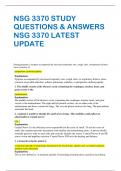
-
NSG 3370 STUDY QUESTIONS & ANSWERS NSG 3370 LATEST UPDATE
- Exam (elaborations) • 72 pages • 2023
-
- $17.49
- + learn more
NSG 3370 STUDY QUESTIONS & ANSWERS NSG 3370 LATEST UPDATE During pregnancy, dyspnea accompanied by increased respiratory rate, cough, rales, orrespiratory distress raises concerns of: peripartum cardiomyopathy Explanation: Dyspnea accompanied by increased respiratory rate, cough, rales, or respiratory distress raises concerns of possible infection, asthma, pulmonary embolus, or peripartum cardiomyopathy. 1. The middle section of the thoracic cavity containing the esophagus, trachea,...
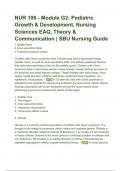
-
NUR 106 - Module G2: Pediatric Growth & Development, Nursing Sciences EAQ, Theory & Communication | SBU Nursing Guide
- Exam (elaborations) • 85 pages • 2024
-
Available in package deal
-
- $7.99
- + learn more
NUR 106 - Module G2: Pediatric Growth & Development, Nursing Sciences EAQ, Theory & Communication | SBU Nursing Guide 1.Saddle Nose 2.Inner epicanthic folds 3.Transverse palmar crease Children with Down syndrome have a broad nose with a depressed bridge (saddle nose), as well as inner epicanthic folds, and oblique palpebral fissures; they also have speckling of the iris (Brushfield spots). Children with Down syndrome have a transverse palmar crease (simian crease) formed by fusion of ...
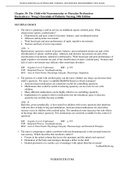
-
Chapter 30: The Child with Neuromuscular or Muscular Dysfunction Hockenberry: Wong’s Essentials of Pediatric Nursing, 10th Edition
- Exam (elaborations) • 11 pages • 2023
-
- $9.49
- + learn more
1. The nurse is planning a staff in-service on childhood spastic cerebral palsy. What characterizes spastic cerebral palsy? a. Hypertonicity and poor control of posture, balance, and coordinated motion b. Athetosis and dystonic movements c. Wide-based gait and poor performance of rapid, repetitive movements d. Tremors and lack of active movement ANS: A Hypertonicity and poor control of posture, balance, and coordinated motion are part of the classification of spastic cerebral palsy. Athe...

That summary you just bought made someone very happy. Also get paid weekly? Sell your study resources on Stuvia! Discover all about earning on Stuvia


